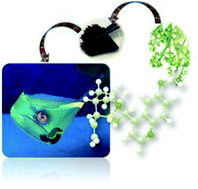当前位置:
X-MOL 学术
›
J. Mater. Chem. B
›
论文详情
Our official English website, www.x-mol.net, welcomes your
feedback! (Note: you will need to create a separate account there.)
Active quinine-based films able to release antimicrobial compounds via melt quaternization at low temperature†
Journal of Materials Chemistry B ( IF 6.1 ) Pub Date : 2017-11-27 00:00:00 , DOI: 10.1039/c7tb02739g Alejandro Latorre-Sánchez 1, 2, 3, 4, 5 , Mats Johansson 6, 7, 8, 9, 10 , Yuning Zhang 6, 7, 8, 9, 10 , Michael Malkoch 6, 7, 8, 9, 10 , José A. Pomposo 1, 2, 3, 4, 5
Journal of Materials Chemistry B ( IF 6.1 ) Pub Date : 2017-11-27 00:00:00 , DOI: 10.1039/c7tb02739g Alejandro Latorre-Sánchez 1, 2, 3, 4, 5 , Mats Johansson 6, 7, 8, 9, 10 , Yuning Zhang 6, 7, 8, 9, 10 , Michael Malkoch 6, 7, 8, 9, 10 , José A. Pomposo 1, 2, 3, 4, 5
Affiliation

|
The fabrication of antibacterial films based on renewable materials (e.g., chitosan) has attracted significant interest in fields such as food packaging, health care and medicine. However, exploiting the antibacterial properties of cinchona alkaloids to design active nanostructured films able to release quinine-based antimicrobial compounds has not been considered previously. Herein, we develop two different routes to produce active quinine-based nanostructured cross-linked films by exploiting the multiple reactive sites of quinine and, specifically, both the nitrogen atom and the vinyl group of the quinuclidine portion of the molecule, as well as their corresponding orthogonal quaternization and thiol–ene coupling reactions. The first synthetic strategy produces stiff and brittle nanostructured quinine-based films of limited utility for practical applications. Conversely, the second approach produces active, flexible and nanostructured quinine-based films (Tg = −14 °C, Young's modulus = 1.3 GPa), which are able to release antimicrobial compounds against E. coli that, remarkably, are noncytotoxic against mouse macrophage and human dermal fibroblast cells. These kinds of active cinchona alkaloid-based coatings are easy to prepare by means of simple, solvent-free, melt quaternization/spreading procedures at a relatively low temperature (120 °C), making this second approach one of the most facile reported procedures to date to produce active nanostructured bio-based films.
中文翻译:

能够在低温下通过熔融季铵化释放抗菌化合物的基于奎宁的活性薄膜†
基于可再生材料的抗菌膜的制造(例如(壳聚糖)在食品包装,保健和医药等领域引起了极大的兴趣。然而,以前没有考虑过利用金鸡纳生物碱的抗菌特性来设计能够释放基于奎宁的抗菌化合物的活性纳米结构薄膜。在本文中,我们通过利用奎宁的多个反应位点,特别是分子中奎宁环部分的氮原子和乙烯基,以及它们各自的活性,开发出两种不同的途径来生产活性的基于奎宁的纳米结构交联膜相应的正交季铵化和硫醇-烯偶联反应。第一种合成策略是生产刚性和脆性的基于奎宁的纳米结构薄膜,在实际应用中用途有限。相反,第二种方法产生主动T g = -14°C,杨氏模量= 1.3 GPa),能够释放出针对大肠杆菌的抗菌化合物,这种化合物对小鼠巨噬细胞和人皮肤成纤维细胞无细胞毒性。这些类型的活性金鸡纳生物碱基涂料很容易通过在相对较低的温度(120°C)下进行的简单,无溶剂,熔融季铵化/铺展的方法来制备,这使该第二种方法成为目前报道最简便的方法之一。迄今已生产出活性的纳米结构生物基薄膜。
更新日期:2017-11-27
中文翻译:

能够在低温下通过熔融季铵化释放抗菌化合物的基于奎宁的活性薄膜†
基于可再生材料的抗菌膜的制造(例如(壳聚糖)在食品包装,保健和医药等领域引起了极大的兴趣。然而,以前没有考虑过利用金鸡纳生物碱的抗菌特性来设计能够释放基于奎宁的抗菌化合物的活性纳米结构薄膜。在本文中,我们通过利用奎宁的多个反应位点,特别是分子中奎宁环部分的氮原子和乙烯基,以及它们各自的活性,开发出两种不同的途径来生产活性的基于奎宁的纳米结构交联膜相应的正交季铵化和硫醇-烯偶联反应。第一种合成策略是生产刚性和脆性的基于奎宁的纳米结构薄膜,在实际应用中用途有限。相反,第二种方法产生主动T g = -14°C,杨氏模量= 1.3 GPa),能够释放出针对大肠杆菌的抗菌化合物,这种化合物对小鼠巨噬细胞和人皮肤成纤维细胞无细胞毒性。这些类型的活性金鸡纳生物碱基涂料很容易通过在相对较低的温度(120°C)下进行的简单,无溶剂,熔融季铵化/铺展的方法来制备,这使该第二种方法成为目前报道最简便的方法之一。迄今已生产出活性的纳米结构生物基薄膜。











































 京公网安备 11010802027423号
京公网安备 11010802027423号